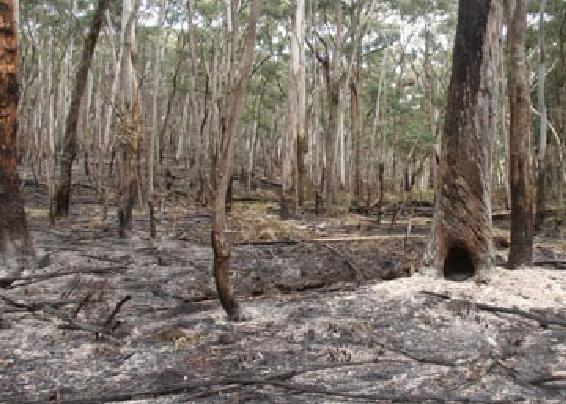Living with fire in the Wombat Forest
By Gayle Osborne

Fire Effects Study Area at Kangaroo Creek (photo by Tibor Hegedis)
For all of us living close to a forest the summer is a time of apprehension. Will this be the year we have the Big Fire? Lessons have been learnt, there are now guidelines to help us survive and save our houses. We reduce the fuel around our houses, prepare our pumps and clothe ourselves appropriately.
However the Fuel Reduction Burning in the forest gives rise to a diversity of opinion. Some residents wish for regular burning of the forest while others raise environmental concerns.
The issues are complex, fuel reduction burning may assist in the control of a wildfire, but the primary issue is the relationship between the fire and the weather. The temperature and the humidity create the conditions and the wind controls the rate of spread of the fire. On Ash Wednesday the temperature rose to 43 degrees and the wind reached gusts of up to 102 km/h. We will never have control over these elements.
Our forests are also complex. Fallen leaves and litter is part of the nutrient cycle. Small insects convert this into nutrients and minerals which are absorbed by the trees. Fire destroys this cycle, nitrogen is lost and nitrogen fixing shrubs replace the litter and can become a fire hazard.
Charcoal records point to our wet forests burning every 300 years prior to European settlement.
The Wombat is not a wet forest but this leads us think about what the natural fire frequency would have been in the Wombat. In the past 200 years we have radically changed the Australian environment, we have used fire as a tool to clear the land and accidentally lit fires which have spread out of control. Frequent large fires and the extinction of many species are our European legacy.
Our forests are flammable but we need to ask if we are making our forests more fire prone by frequently burning large areas. If we leave the forest alone and allow the natural systems to operate, will the forest be more resistant to the damage from wildfire?
Thousands of hectares of the Wombat Forest are listed for fuel reduction burns over the next three years. In most of these burns 80 - 90% of the area will be burnt regardless of gullies or drainage lines. One thousand hectares is listed for an area west of Blakeville, which is home to our largest population of Greater Gliders. The Gliders are not necessarily safe in their hollows during the burn; they can suffer smoke inhalation which can lead to pneumonia and death.
As a community we need to consider these issues, can we be more strategic with fuel reduction? Is it necessary to repeatedly burn large areas in the forest?
Members of Wombat Forestcare have made submissions to the Fire Operations Plan raising many ecological issues and are hopeful that DSE in the planning of fuel reduction will consider these issues.
BURN, The Epic Story of Bushfire in Australia, by Paul Collins is recommended reading on this topic. BURN is published by Allen & Unwin (ISBN 1-74175-053-9).
